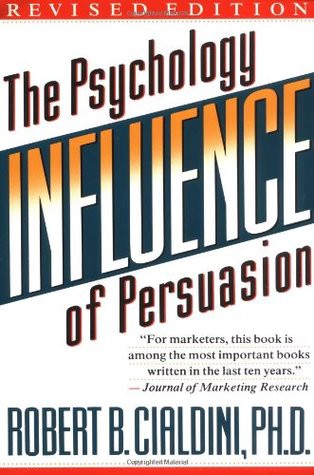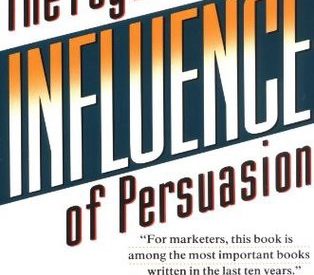
Rating ? 5/5
Influence, the classic book on persuasion, has sold over three million copies and has been translated into thirty languages. It has been listed on the New York Times Best Seller list and Fortune lists it in their ?75 Smartest Business Books?. It has been mentioned in 50 Psychology Classics.
I often ask guests on my podcast to recommend their favorite books and Influence figures up in the top three books in the recommendation.
The book explains the psychology of why people say ?yes? ? and how to apply these understandings. Dr. Robert Cialdini is the expert in the field of influence and persuasion. His thirty-five years of rigorous, evidence-based research along with a three-year program of study on what moves people to change behavior has resulted in this highly acclaimed book.
You?ll learn the six universal principles, how to use them to become a skilled persuader ? and how to defend yourself against them. Perfect for people in all walks of life, the principles of Influence will move you toward profound personal change and act as a driving force for your success.
Here are the 6 main principles explored in this book:
- Reciprocation
- Commitment & Consistency
- Social Proof
- Authority
- Liking
- Scarcity
1. RECIPROCATION
This rule states that ??we should try to repay, in kind, what another person has provided us.?
One of the reasons reciprocation can be used so effectively as a device for gaining another?s compliance is its power. The rule possesses awesome strength, often producing a ?yes? response to a request that, except for an existing feeling of indebtedness, would have surely been refused.
Examples:
- If someone buys you lunch, you feel obligated to buy them lunch next time.
- At the supermarket, or a warehouse club like Costco, ?free? samples encourage the reciprocity rule when they make you buy something you wouldn?t have otherwise.
- For the ladies, if a guy takes you out to an expensive dinner, you feel obligated to go out with him again even though you weren?t that into him.
2. COMMITMENT & CONSISTENCY
This principle is about our ??desire to be (and to appear) consistent with what we have already done. Once we have made a choice or taken a stand, we will encounter personal and interpersonal pressures to behave consistently with that commitment. Those pressures will cause us to respond in ways that justify our earlier decision.?
Some examples:
- Maintaining your religious affiliation, even though there isn?t a shred of evidence that confirms what you believe is in any way true.
- You stay married, even though divorce may be the best option, because you?ve made a public commitment ?til death do us part?.
- You?ve made it public knowledge that you believe President Obama was born in Kenya and continue to bring up the issue, even though there is substantial evidence indicating he was in fact born in Hawaii.
- You tell everyone you?re running your 1st marathon in 3 months. The public announcement, or what I call ?forced accountability,? will motivate you to be more consistent in your training so you hit your goal.

3. SOCIAL PROOF
Social proof is what a lot of us would refer to as peer pressure, but I think it?s closer to herd behavior. This rule ??applies especially to the way we decide what constitutes correct behavior. We view a behavior as more correct in a given situation to the degree that we see others performing it.? Basically, everyone else is doing it, so I?ll do it too.
For example:
- You?re at a bar and your 4 friends order margaritas, so you do the same.
- You start wearing your jeans really low because all your friends are doing it.
- You laugh at a joke because your friends are laughing, but you don?t even get it.
- You see everyone else staring up at the sky, so you look up too (works every time).
4. LIKING
Very simply, this just means we prefer to say yes to the requests of people we know and like.
But what are the factors that cause one person to like another person?
- A) Physical Attractiveness: Want to know why Kim Kardashian has almost 10 Million (https://www.facebook.com/KimKardashian ) ?likes? on Facebook, her own reality show and a clothing line at Sears?? Sorry, it?s not because she?s super smart or talented ? it?s mostly because she?s super hot and dresses really well. And since she?s super hot and dresses really well, people like her and want to be associated with her.
- B)Similarity: We like people who are similar to us, whether it?s sharing opinions, personality traits, background, lifestyle, etc.
A good example are the cliques that form in high school: athletes, nerds, band geeks, etc. ? everyone found a group they associated with the most. And if you were a total social outcast, you probably associated with other outcasts.
We see the same dynamic within agencies: Planners hang out with Planners, Creatives hang out with Creatives, and so on.
- C)Compliments: We generally love getting compliments, even if they?re not true. Of course, YOU wouldn?t fall for it. I mean, you?re incredibly smart and fun to be around. Did I mention the fact that you?re insanely good-looking? Yes, YOU!!
- D) Contact: We like things that are familiar to us. On the other hand, we often fear what we don?t know.
Some examples:
- Contact is one reason people try to eat at the same restaurants over and over and over again instead of trying a new place.
- Contact is also why African-American voters overwhelmingly voted for Obama in his presidential election and why presidential candidates are most likely to win in their home states. Because they?re familiar and ?closer to home.?
- You find out the new girl at work was in the same school. And loves Adele! And cupcakes!! Guess what? You just became BFFs!!
- E) Cooperation: Cooperation works a little differently. We also like people who work with us, instead of against us. Working together towards a common goal and being ?on the same side? are very powerful.
Examples:
- It helps us understand why ?Yes We Can? worked so well as a unifying slogan for the 2008 Obama campaign.
- You work together on a new business pitch
- Sports teams
- We see this all the time in reality shows, like the tribes or alliances formed in ?Survivor? or the ?Real Word/Road Rules Challenge.?
- F) Conditioning & Association: ?All things being equal, you root for your own sex, your own culture, your own locality?and what you want to prove is that YOU are better than the other person. Whomever you root for represents YOU; and when he wins, YOU win.? ? Isaac Asimov
The principle of Association ??is a general one, governing both negative and positive connections. An innocent association with either bad things or good things will influence how people feel about us.?
Everyone wants to be part of a winning team because it raises your social standing. People will therefore try to link themselves to positive events and distance themselves from negative events.
Examples:
- Ever notice how people says ?WE won!!? when their team wins, but they say ?THEY lost!!? when their team loses??
- Of course, it?s the same idea with brands: Starbucks, Apple, Coach, etc. We buy these brands largely because of the Association rule.
- The same rule applies to name droppers, who want you to know who they know (did I mention my neighbors in high school were Das EFX? I didn?t? Oh, ok. No big deal.).
5. AUTHORITY
Very simply, people tend to follow authority figures. We are taught from a very young age that obedience to authority is right and disobedience is wrong.
Examples:
- Policemen, firemen, clergy, office managers, etc.
- Titles (PhD, Esq, MBA, etc.)
- The way people are dressed (Ex: 3-piece suit vs. tank top and board shorts). Con artists exploit this rule all the time, like Leonardo DiCaprio in ?Catch Me If You Can.?
- In Advertising, we see this principle at play in celebrity endorsements.
6. SCARCITY
The scarcity principle states that ??opportunities seem more valuable to us when their availability is limited.? Fans of behavioral economists may see how this ties into the concept of Loss Aversion ? the fear of loss is always greater than the desire for gain.
Examples:
- Limited time offers ? A certain product is in short supply that cannot be guaranteed to last long (like Missoni at Target several months ago or Tickle Me Elmo several years ago).
- Deadlines ? An official time limit is placed on the customer?s opportunity to get the offer. Black Friday and Cyber Monday are great examples.
- Another variant of the deadline tactic is when you?re told that you have to buy NOW or the price will go up very soon (Ex: health club memberships, buying a car, etc.).
Why does the Scarcity principle work so effectively?
??we know that the things that are difficult to possess are typically better than those that are easy to possess, we can often use an item?s availability to help us quickly and correctly decide on its quality.? Rather than weighing all the pros and cons, we use scarcity as a mental shortcut to make decisions.



